Defence Real Property Portfolio Strategy
Foreword – Joint Message from the Deputy Minister and Chief of the Defence Staff

Construction of the Mattawa Plains Complex (MPC) in CFB Petawawa
We are proud to present the Defence Real Property Portfolio Strategy (DRPPS). This document builds on the excellent work that the Department of National Defence (DND) has undertaken over the years to centralize and modernize the largest real property (RP) portfolio in the Government of Canada. Continuing our journey to transform the way we manage DND’s real property portfolio requires a rigorous and innovative re-thinking. Our objective to enable our world-class military depends on a modern and responsive portfolio to meet not only current, but our future needs.
The defence real property portfolio is a core enabler and strategic asset for DND and the Canadian Armed Forces (CAF) and directly impacts our relationships with local communities. It is an important factor in our recruitment and retention efforts because it is where our people live, work, train, operate, and where our equipment and weapons are stored. This strategy sets out a long-term vision and approach to transform our portfolio. To support the implementation of the strategy, DND/CAF stakeholders must be prepared to make challenging decisions to right-size our RP portfolio, where feasible and appropriate. We need to proactively identify opportunities to optimize and consolidate underutilized RP assets in order to facilitate our transition towards more modern, multifunctional and client-centric assets. This strategy is the long-term strategic roadmap that will enable the Defence Team to address portfolio affordability and sustainability challenges, improve alignment with and enhance military capabilities, and better support DND and CAF operations.
Additionally, with the implementation of our strategy, DND will also make significant progress in delivering many of our core commitments under Canada’s Defence Policy: Strong, Secure, Engaged. We are confident that implementing this strategy will provide the right direction and guidance for the prudent management of the portfolio, one that better supports our capabilities and provides long-term financial, environmental and social sustainability. It supports the advancement of broader Government of Canada priorities, including resiliency against climate change and achievement of net-zero carbon emissions by 2050, advancing reconciliation with Indigenous peoples and the broader transition towards the future of work vision. We are committed to this long-term approach and rely on the Defence Team, the Commanders, and Senior Managers to provide the required support and leadership to deliver targeted outcomes.
The DRPPS will be formally reviewed every five years and regularly updated to address policy changes, as required. Together, the Defence Team will ensure it remains relevant and responsive to the defence role, missions, and effectively supports the modern military that Canadians expect and deserve.
Bill Matthews
Deputy Minister
General Wayne Eyre
Chief of the Defence Staff
A Message from Assistant Deputy Minister (Infrastructure & Environment)
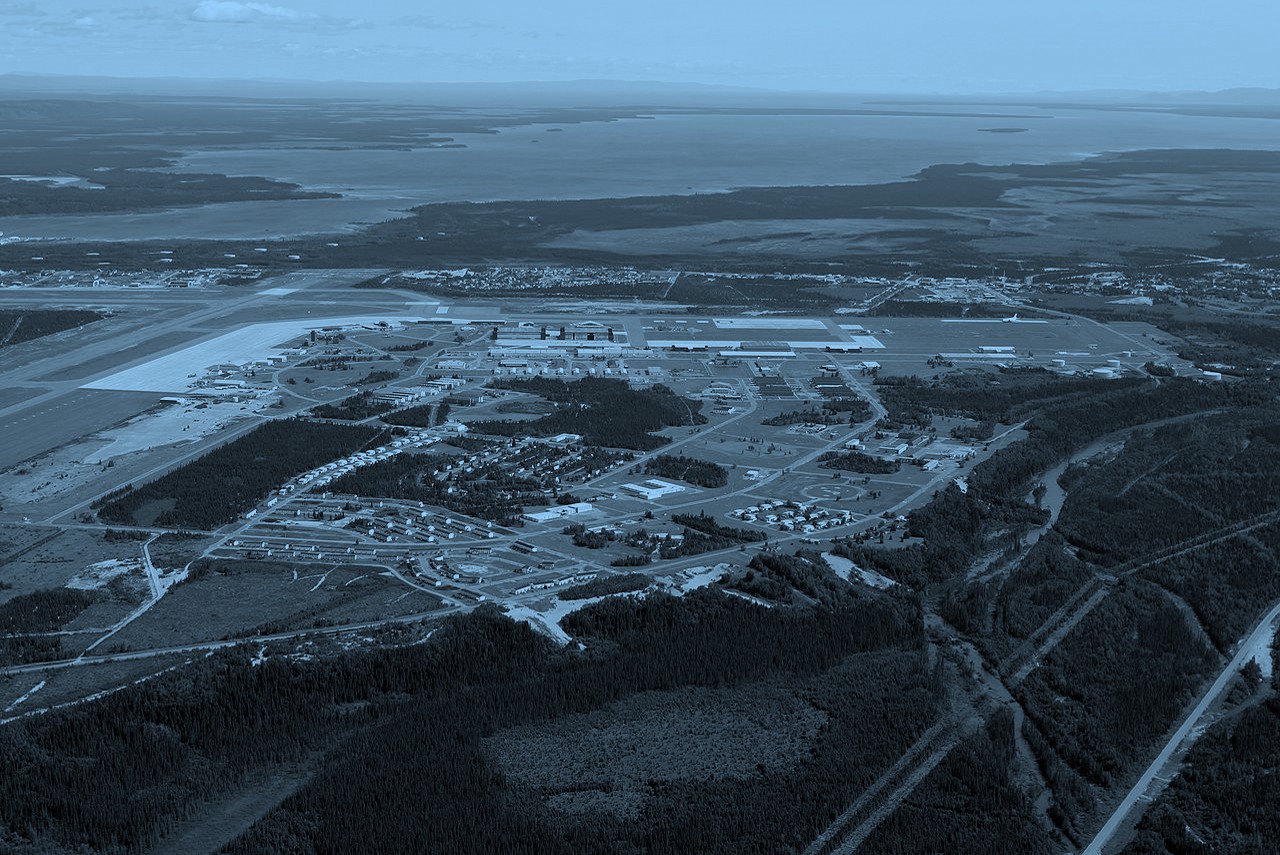
Aerial view of CFB Goose Bay
I am pleased to present you with the Defence Real Property Portfolio Strategy (DRPPS), our assessment of where the Department of National Defence’s (DND) portfolio of real property (RP) should be within its long-term planning horizon. ADM(IE), as custodian of the DND and the Canadian Armed Forces(CAF) real property portfolio, is strengthening its role as strategic partner and critical enabler of Canada’s defence capability, supporting the sustainment of the CAF. Moreover, the DRPPS speaks to ADM(IE)’s expectations about the future and why we believe we need to go in this direction to achieve our goals, and what we must be prepared to do to get there.
ADM(IE) has embarked on a reset of its real property portfolio management regime and that direction is led and supported by the DRPPS. The drivers for this strategy include the current size, age, and condition of our real property portfolio, its wide variety of assets as well as our custodial management obligations and considerations (i.e., Treasury Board Directive on the Management of Real Property and Canada’s Defence Policy: Strong, Secure, Engaged. The DRPPS is also an important step towards addressing the deteriorating condition of our portfolio as a large portion will be reaching the end of its economic life by 2030. This reinforces the need to act and address RP portfolio risks that would impact the successful delivery of Defence capabilities.
Subsequently, this strategy adopts a risk-based approach that recognizes the importance of maintaining and recapitalizing DND/CAF real property in alignment with our operational capabilities and requirements.
It establishes a common understanding of the current condition of the portfolio so that ADM(IE) can prioritize and allocate the necessary funding to key assets and improve related planning and decision-making processes.
The DRPPS is a continuation of the foundational changes that have already been achieved to date in modernizing the largest portfolio in the Government of Canada. It leverages the results of these ongoing efforts and unifies them into a cohesive roadmap for our organization. It highlights the need for proactive planning to anticipate requirements, such as green infrastructure and resiliency against climate change and cyber threats, and focuses on long-term financial, environmental and social sustainability. The strategy drives the modernization of our infrastructure and portfolio management practices and is aligned with the Government of Canada’s future of work vision.
While these are ambitious goals, I am confident that the DRPPS will provide the necessary strategic direction for the prudent management of our real property portfolio that will ultimately be more affordable, efficient, innovative and responsive to DND’s needs. We are committed to implementing the DRPPS and your ongoing support will ensure that we are ready to meet the challenges ahead, as we deliver on the strategic goals outlined in this document over the coming years.
Rob Chambers
Assistant Deputy Minister (Infrastructure & Environment)
The Defence Real Property Portfolio at a glance
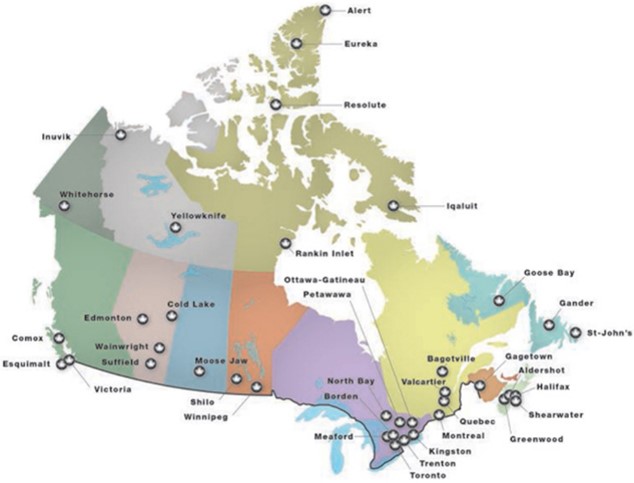
Long description of CAF Bases and Installations in Canada
Bases in Canada
- Inuvik, North West Territories
- Whitehorse, North West Territories
- Yellowknife, North West Territories
- Alert, North West Territories
- Eureka: Qikiqtaaluk Region, Nunavut
- Resolute: Qikiqtaaluk Region, Nunavut
- Iqaluit, Nunavut
- Rankin Inlet, Nunavut
- Ottawa–Gatineau – Ottawa, Ontario
- Petawawa, Ontario
- Comox, British Columbia
- Esquimalt, British Columbia
- Edmonton, Alberta
- Wainwright, Alberta
- Suffield, Alberta
- Victoria, British Columbia
- Cold Lake, Alberta
- Moose Jaw, Saskatchewan
- Shilo, Manitoba
- Winnipeg, Manitoba
- North Bay, Ontario
- Borden, Ontario
- Meaford, Ontario
- Valcartier, Quebec
- Bagotville, Quebec
- Toronto, Ontario
- Trenton – Quinte West, Ontario
- Kingston, Ontario
- Montreal, Quebec
- Gagetown, New Brunswick
- Aldershot – Burlington, Ontario
- Halifax, Nova Scotia
- Shearwater, Nova Scotia
- Greenwood, Nova Scotia
- Goose Bay, Newfoundland and Labrador
- Gander, Newfoundland and Labrador
- St. John’s, Newfoundland and Labrador
Canada has:
- 2.2 million hectares of land (including operational and training sites)
- 12,000 residential houses
- 5,500 kilometres of roads
- 21,000 buildings
- 25% of assets >50 years old
- operational, training, welfare and logistics facilities
- built assets that value $28 billion
- 13,500 works
- 10 million m2 of floor space 519,000 m2 under PSPC
- approx. $2 billion annual operational budget
Part 1 – Outline
Introduction
The Department of National Defence’s (DND) and Canadian Armed Forces (CAF) real property (RP) is essential to support defence capabilities and core institutional functions. It provides the property, the works and the facilities necessary to generate and maintain military capabilities and skills.
The current portfolio requires a stronger strategic vision in order to consistently fulfill the modern requirements of DND and the CAF. Much of the existing RP was not designed for today’s operational needs. In addition, a significant proportion of the assets are at the end of their life cycle and are forecasted to be in “critical” condition by 2030. Therefore, a more consistent enterprise-wide approach is needed to:
- maintain and recapitalize new and existing assets;
- address urgent and declining infrastructure conditions;
- reduce the portfolio footprint;
- align the portfolio with current and future objectives;
- consider long-term environmental sustainability; and,
- consider the interests of Indigenous groups.
As the sole custodian and Senior Designated Official for the Department’s real property, ADM(IE) is responsible for supporting the deputy head’s accountability for RP. It operates at the centre of a RP community whose members include other DND/CAF Level one (L1) organizations to deliver on the initiatives outlined in Canada’s Defence Policy: Strong, Secure, Engaged (SSE).
Through the Defence Real Property Portfolio Strategy (DRPPS), the Department takes a comprehensive and risk-based approach to improve the long-term management of defence real property.
The overall size, condition, and complexity of DND’s portfolio has given rise to the requirement for this Strategy. Relevant obligations and considerations include (but are not limited to):
- Meeting the operational needs of DND/CAF stakeholders;
- Meeting the obligations under SSE to ensure that the portfolio can fulfill the current and future needs of DND and the CAF;
- Demonstrating alignment with and contributing to the Government’s real property management objectives in terms of security, resiliency, sustainability and affordability;
- Contributing to the Government’s commitment to minimizing environmental impacts and ensuring the environmental sustainability of the portfolio, including climate resiliency and carbon neutrality;
- Supporting the Government’s commitment to reconciliation with Indigenous peoples and fulfillment of these obligations in the management of the portfolio;
- Addressing Treasury Board’s (TB) Horizontal Fixed Asset Review recommendations and requirement to develop a departmental real property portfolio strategy (per Directive on the Management of Real Property); and,
- Addressing other required compliance with the updated TB real property management policy suite.
Overview

Dining facility at CFB Borden
The DRPPS is a long-term approach aligned with TB’s Directive on the Management of Real Property. It is intended to provide the supporting structure, context, and directions to facilitate the integration and effective management of the portfolio. It orients activities toward the achievement of results and ensures good stewardship of public resources and assets. Furthermore, it includes high-level priorities and strategic actions that provide a high standard of management excellence in support of CAF operational readiness and programme requirements.
The Strategy is a significant step forward for the Department, as it fills a gap in strategic portfolio planning by providing an enterprise-wide approach as to how DND should manage its portfolio and inform asset-level investment decisions moving forward. It will be reviewed as required to respond to broader DND strategic guidance and corporate planning activities, including reports of the Office of the Auditor General of Canada, Canada’s Defence Policy: Strong, Secure, Engaged, the Departmental Results Framework, the Departmental Plan, the Defence Investment Plan, and Defence Energy and Environmental Strategy.
To ensure the DND/CAF RP portfolio can continue to support defence capabilities and core institutional functions, while contributing to broader Government of Canada priorities, the portfolio approach focuses on the delivery of modern, flexible and affordable assets that are client-centric and multifunctional to meet both current and future needs.
The Department will leverage a risk-based portfolio tiering approach to prioritize assets that meet both current and future requirements. Relevant actions will be taken to maintain, recapitalize, optimize, replace, acquire, divest or demolish assets based on their overall asset life cycle condition, suitability and financial and physical performance.
In delivering a modern portfolio, DND aims to provide the best value for money in the provision of real property required to deliver on current and future capabilities. This may include the sale, purchase, lease, renovation, upgrade or replacement of assets. The portfolio cannot be constrained by the current configuration and must be optimized and consolidated, to deliver fewer, high-quality and multifunctional and/or modular assets, where feasible and appropriate. Consideration will also be given to innovative business processes and practices across the organization, including ways to improve asset management systems and explore partnerships.
Part 2 – Current and Future State
Current State
The DND administers the largest real property portfolio in the Government of Canada. The portfolio stretches from coast to coast to coast, occupying approximately 10 million square metres of floor space, 21,000 buildings (including more than 12,000 residential units), 2.2 million hectares of land, and 13,500 works including roads, water, storm and sewer pipes, airfields, jetties, ranges and training areas. The portfolio has a total replacement cost of approximately $28 billion with an approximate annual budget of $2.0 billion.
The DND/CAF real property portfolio is experiencing similar challenges as those held by other federal RP custodial departments and agencies. The state of the portfolio is consistent with the overall Government of Canada’s real property portfolio as the average age of assets is increasing, overall portfolio condition is deteriorating, deferred maintenance costs continue to grow, and the functionality and suitability of the portfolio is declining.
The portfolio is geographically dispersed and complex, with a wide variety of facilities of differing ages, uses, and conditions. With a more than a quarter of infrastructure over 50 years old, DND/CAF assets and municipal works are reaching the end of their economic life and, therefore, becoming ill-suited to support current and future missions and military members. Ongoing efforts are underway to improve the condition of assets to mitigate the risk of incidents that would impact infrastructure and operational readiness in addition to posing health and safety risks.
Through portfolio modernization, ADM(IE) is also increasing the energy efficiency of defence infrastructure, reducing greenhouse gas (GHG) emissions, and providing modern green facilities to support personnel. To help the Government of Canada achieve long-term resiliency to the impacts of climate change and net-zero carbon emissions by 2050, ADM(IE) has implemented energy performance contracts, designated energy managers at all bases and wings across the country, purchased clean power, greened the commercial light-duty vehicle fleet, and invested in energy efficient buildings and upgrades to existing facilities. As of 2020-21, Defence had reduced GHG emissions from buildings and non-military vehicles by about 37% from 2005 levels.
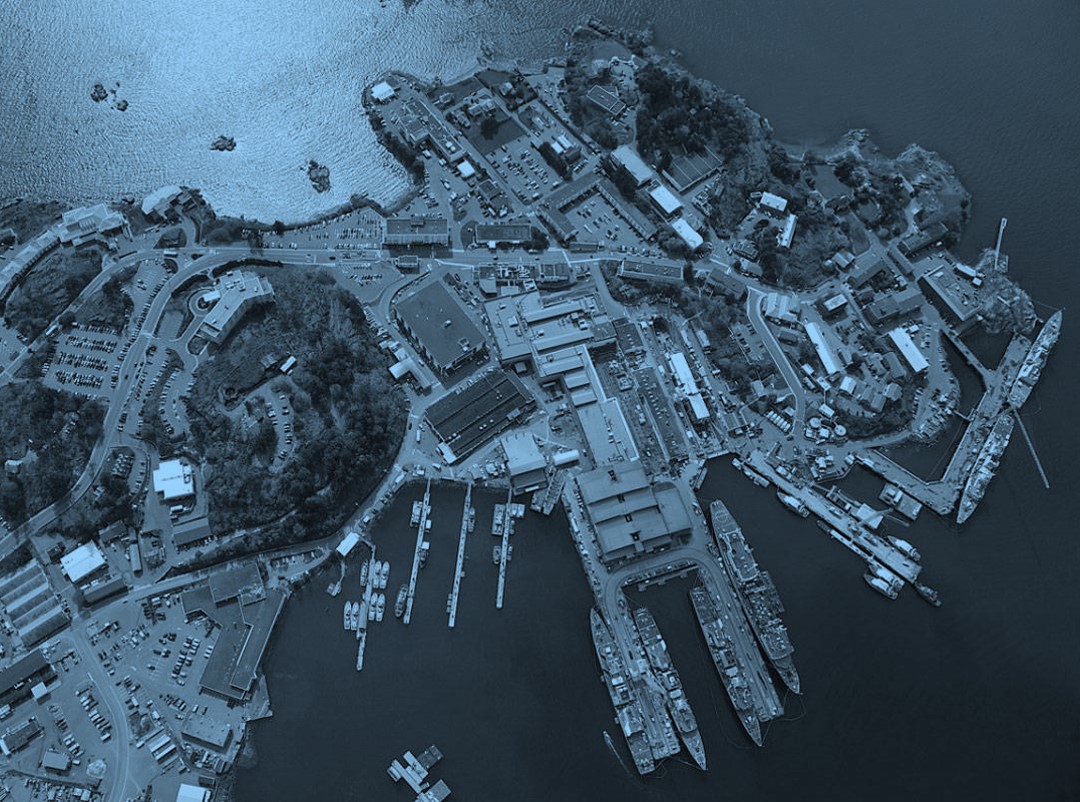
Aerial view of CFB Esquimalt
In addition, the COVID-19 pandemic has helped to rapidly accelerate workplace modernization by driving fundamental change in how and where some employees work and related investments to modernize new and existing locations. In response to evolving priorities, the Department has continued to promote flexible work arrangements, including unassigned and activity-based work environments and remote working, where possible. Nonetheless, many staff members remain essential to enabling critical functions, strategic and operational command and control, and provide support to operations and must continue to physically enter their workplace(s). DND is exploring post-pandemic impacts on the real property portfolio and re-assessing potential portfolio modernization and rationalization opportunities as the situation evolves.
Vision and Future State
A modern, optimized and affordable RP portfolio that enables the operational success of DND and the CAF in a manner that respects the environment and Indigenous interests
Part 3 – Context
Strategic Planning Environment
The DND/CAF operating context inherently guides the DRPPS as a conceptual framework, including its strategic approach and broader decision-making environment
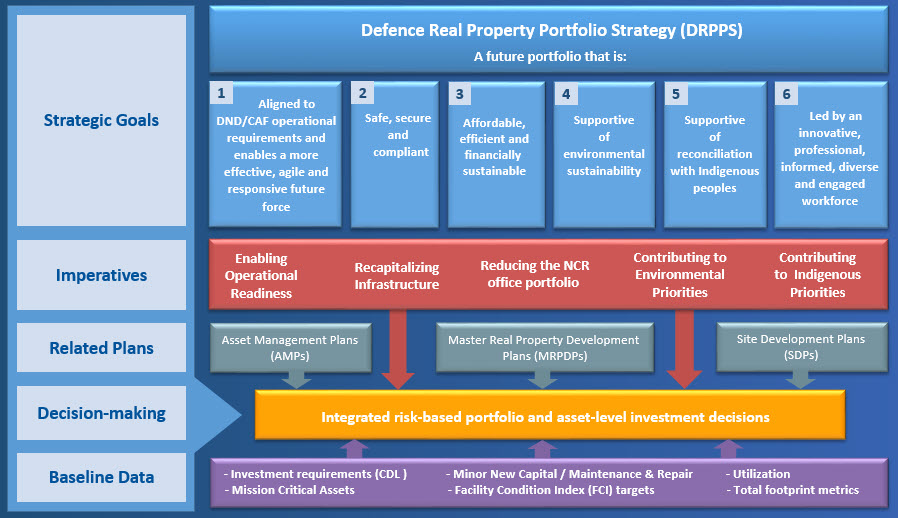
Description of Strategic Planning Environment infographic
Key Actions
Step 1 - Business needs based on data (demand)Footnote * Step 2 - Analyze data to define portfolio plan Step 3 - Resource allocation Step 4 - Plan Investments Step 5 - Deliver Outcomes Assemble internal and external asset portfolio data.
Evaluate asset portfolio using agreed-upon criteria to identify preliminary actions for each asset, e.g.:
- Retain or renew
- Maintain
- Assess or reconsider
- Dispose or terminate
Prioritize internally consistent actions and decisions across the portfolio, identifying:
- Strategic alignment
- Capabilities
- Timelines
- Risks / dependencies
- Investment required
Conduct robust planning and finalize resource allocation
Execute plans
Determine preliminary business needs / capital demand including assets of strategic importance.
Conduct prioritization and sequencing of actions
Continuous monitoring, evaluation, and adjustments
Lead Practices
Step 1 - Business needs based on data (demand)Footnote * Step 2 - Analyze data to define portfolio plan Step 3 - Resource allocation Step 4 - Plan Investments Step 5 - Deliver Outcomes Determine asset needs of DND/CAF stakeholders
Criteria developed in collaboration with key DND/CAF stakeholders
Robust financial modelling
Resource allocation is subject to established governance processes
Plans are adjusted continuously, not merely on an annual basis
Future needs based on organizational strategies and leadership insights
Criteria may include value-add, cost, risk, effort, etc
Scenarios are developed with all stakeholder groups involved
Leverage enterprise systems
Benefits
Step 1 - Business needs based on data (demand)Footnote * Step 2 - Analyze data to define portfolio plan Step 3 - Resource allocation Step 4 - Plan Investments Step 5 - Deliver Outcomes Benefits
Challenges
Better asset base
Focus on data-driven results
Implications across corporate planning
Perceived reduction in authority
Consistent methodology
Transparency
Stakeholder buy-in
Requirements may be challenged
Rationalization – fit for purpose
Aligned with operational realities
Facility management
Strategic Imperatives
The achievement of the DRPPS’ strategic goals is contingent on effective monitoring, reporting, and performance assessment.
| Imperatives | Goal | Performance Indicators | Target | Timeline |
|---|---|---|---|---|
| Enabling operational readiness | 1 | % of total infrastructure in fair or better condition | 70% | 2032 (Within 10 years) |
| Recapitalizing Infrastructure | 1 | % of square metres of the portfolio recapitalized relative to 2022 (per the latest applicable standards and building codes) | 20% | |
| Reducing the NCR office portfolio | 3 | % of square metres of the NCR office portfolio reduced relative to 2022 | 20% | |
| Contributing to Environmental priorities | 4 | % of Defence Energy and Environment Strategy (DEES) real property commitments met/exceeded | 100% | Ongoing (Annually as of FY 2022/23) |
| Contributing to Indigenous priorities | 5 | % of overall value of real property related contracts awarded to Indigenous Businesses | ≥5% |
Risk Management
Key risks associated with managing the portfolio include (but are not limited to):
- Strategic
- Financial
- Operational
- Reputational
- Health and safety
- Compliance
The DRPPS adopts an enterprise-wide risk management approach to reduce and mitigate portfolio-based risks and to ensure that:
- All capital and maintenance investments in existing and new assets are aligned with the strategic portfolio goals, support DND/CAF operations and capabilities and associated programme/project approval decisions are within the existing funding profile
- Limited funding is maximized to maintain and improve the RP portfolio and address the forecasted “critical” rating by 2030 (based on Facility Condition Index metrics and current spending levels on deferred maintenance)
- Efforts to reduce the portfolio’s footprint via rationalization, joint-use and multi-functional facilities, consolidation and modernization are proactively exercised, where feasible
- Enterprise-wide risks, including difficulty in procuring, building and managing RP infrastructure at the right level to support operations and changes to the physical environment of Canada and the world impacting the type, frequency, and conduct of DND/CAF activities, are proactively assessed, tracked and mitigated
Part 4 – Strategic Goals
Strategic Goal 1 (OAG, SSE, DRF, DP)
A real property portfolio that is aligned to the DND and CAF prioritized operational requirements and enables a more effective, agile and responsive future force
| - | Priorities | Strategic Actions |
|---|---|---|
| 1.1 | Develop National Real Property Portfolio Plan by 2024 |
|
| 1.2 | Develop Real Property Asset Management Framework, Strategy and Plans |
|
| 1.3 | Complete a review of infrastructure asset utilization and functionality for major assets |
|
| 1.4 | Improve the capture of future DND and CAF real property requirements |
|
Strategic Goal 2 (SSE, DRF, DP)
A real property portfolio that is safe, secure and compliant
| - | Priorities | Strategic Actions |
|---|---|---|
| 2.1 | Improve Real Property Compliance Framework |
|
| 2.2 | Ensure RP Risk-based Compliance |
|
| 2.3 | Comply with Accessibility Standards and Requirements |
|
| 2.4 | Review and improve Construction Policies and Standards to include sustainability, resiliency, flexibility, reusable concepts and optimized concept elements |
|
| 2.5 | Implement Real Property Portfolio Risk Strategies |
|
| 2.6 | Ensure Compliance with CDS/DM Directive on Gender-Based Analysis Plus |
|
| 2.7 | Modernize the DND Built Heritage Strategy |
|
Strategic Goal 3 (OAG, SSE, DRF, DP)
A real property portfolio that is affordable, efficient and financially sustainable
| - | Priorities | Strategic Actions |
|---|---|---|
| 3.1 | Develop and implement a Long‐Term Funding Strategy and RP Cost‐Saving Strategies by 2025 |
|
| 3.2 | Update Real Property Investment Management Framework, Governance, Strategy and Plans |
|
| 3.3 | Finalize implementation of Real Property Investment Management Board by 2022 |
|
| 3.4 | Improve capture and reporting of total lifecycle operating costs |
|
| 3.5 | Improve the Collection and Management of Real Property Portfolio information |
|
Strategic Goal 4 (OAG, SSE, DP)
A real property portfolio that is supportive of environmental sustainability
In alignment with the Defence Energy and Environment Strategy (DEES):
| - | Priorities | Strategic Actions |
|---|---|---|
| 4.1 | Greening Government |
|
| 4.2 | Safe and Healthy Communities |
|
Strategic Goal 5 (OAG, SSE, DP)
A real property portfolio that is supportive of Indigenous reconciliation
| - | Priorities | Strategic Actions |
|---|---|---|
| 5.1 | Support the Government of Canada’s commitment to reconciliation with Indigenous groups |
|
Strategic Goal 6 (OAG, SSE, DP)
A real property portfolio that is led by an innovative, professional, informed, diverse and engaged workforce
| - | Priorities | Strategic Actions |
|---|---|---|
| 6.1 | Develop and implement a Communications Plan |
|
| 6.2 | Modernize the Real Property Management Framework, including accountabilities and authorities |
|
| 6.3 | Ensure HR Strategy is in line with the portfolio capacity needs |
|
| 6.4 | Modernize Real Property management business processes |
|
| 6.5 | Facilitate public consultation and local community engagement |
|
| 6.6 | Improve real property innovation opportunities |
|
Part 5 – Portfolio Tiering
Tiering OptionsFootnote *
Per TB direction, DND/CAF is adopting a risk-based portfolio tiering approach to prioritize asset-level investments based on their life cycle and assess their ability to meet DND and CAF current and future needs within the existing funding profile
| Tier | Priority | Options availableFootnote ** |
|---|---|---|
| Tier 1 | The property or asset has high financial performance, and aligns well with strategic objectives of DND and CAF | Retain or renew |
| Tier 2 | The property or asset has good financial performance and aligns with strategic objectives of DND and CAF | Maintain |
| Tier 3 | The property or asset has fair financial performance and/or may not align well with strategic objectives of DND and CAF (or vice-versa) | Assess or reconsider |
| Tier 4 | The property or asset has poor financial performance and/or does not align with strategic objectives of DND and CAF | Dispose or terminate |

Long description of Current and Future State graphs
Current State
- Tier 1 – 10%
- Tier 2 – 20%
- Tier 3 – 30%
- Tier 4 – 40%
Future State
- Tier 1 – 40%
- Tier 2 – 30%
- Tier 3 – 20%
- Tier 4 – 10%
Tiering Methodology
Preliminary tiering of the DND/CAF RP portfolio will be completed for most major assets to support the achievement of the strategic goals. The following methodology will be adopted to determine the value of individual assets and their recommended tier.
Tiering Criteria
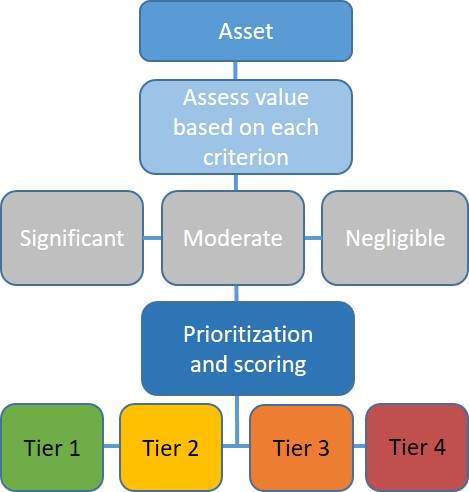
Long description of Tiering Criteria flowchart
- Asset
- Assess value based on each criterion
- Significant
- Moderate
- Negligible
- Prioritization and scoring
- Tier 1
- Tier 2
- Tier 3
- Tier 4
- Assess value based on each criterion
- Asset
- Financial Performance – Total cost of ownership (including operations, maintenance and repair) over an asset’s life cycle
- Geography – Ability to consolidate operations, maintenance or space and co-location opportunities between branches and functions
- Criticality – Assets that are currently or will be essential to the operations of DND and CAF as a whole
- Facility Condition – Maintenance required versus the priority of the asset to current and future needs
- Utilization – Overall utilization of an asset (based on data and analytics) to inform opportunities related to capital
- Future Growth and Demand – Considers both supply and demand while recognizing the need to remain adaptable in an uncertain world
- Functionality – Reviews the assets by operational capability to evaluate cost reduction opportunities and identify unnecessary redundancies
- Suitability – Considers whether an asset provides appropriate functional and spatial conditions to support end-user requirements
- Indigenous Reconciliation – Considers RP decisions that contribute to the reconciliation with Indigenous peoples
- Environmental Sustainability – Considers the long-term impact of DND/CAF RP footprint on the environment (and vice-versa)
- Federal Presence – Considers the proximity of DND/CAF to local communities and related impact(s)
Tiering Process
| - | Business needs based on data (demand) | Analyze data to define portfolio plan | Resource allocation | Plan investments | Deliver outcomes |
|---|---|---|---|---|---|
| Key actions |
|
|
|
|
|
| Leading practices |
|
|
|
|
|
Benefits
|
|||||
Challenges
|
|||||
Part 6 – Conclusion and Annexes
Conclusion
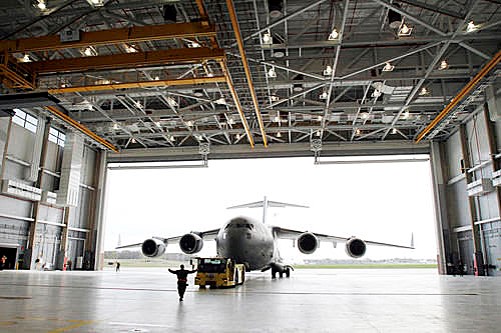
Maintenance hangar at CFB Trenton
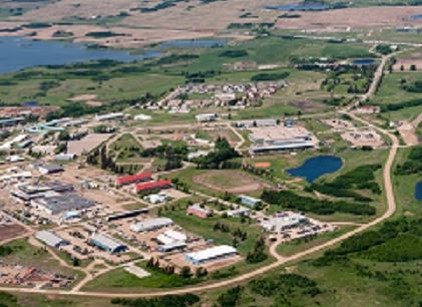
Aerial view of CFB Wainwright
This enterprise-wide RP portfolio strategy will directly contribute to support CAF modern military capabilities while enabling long-term real property sustainability. DND/CAF assets are rapidly approaching conditions that will impact CAF’s ability to deliver and maintain operational readiness. The existing incremental approach to managing real property assets cannot address the systemic gaps that are emerging across the portfolio. As such, opportunities must be sought to optimize the RP portfolio and ensure that the strategic actions and investment decisions effectively address the current and future needs of the CAF.
The DRPPS is the key document that articulates the portfolio vision, guiding principles and high-level objectives and establishes a roadmap towards achieving the desired future portfolio state. By leveraging a “risk-based” model that balances affordability with risk, the DRPPS weighs long-term priorities against available analytics to make the best possible strategic decisions. Furthermore, it aims to allocate limited funding towards high-priority assets and investments.
This strategy provides DND with a path towards long-term financial sustainability. It also ensures compliance with Government of Canada and departmental policies/directives, while addressing DND/CAF operational requirements and supporting the achievement of broader government priorities.
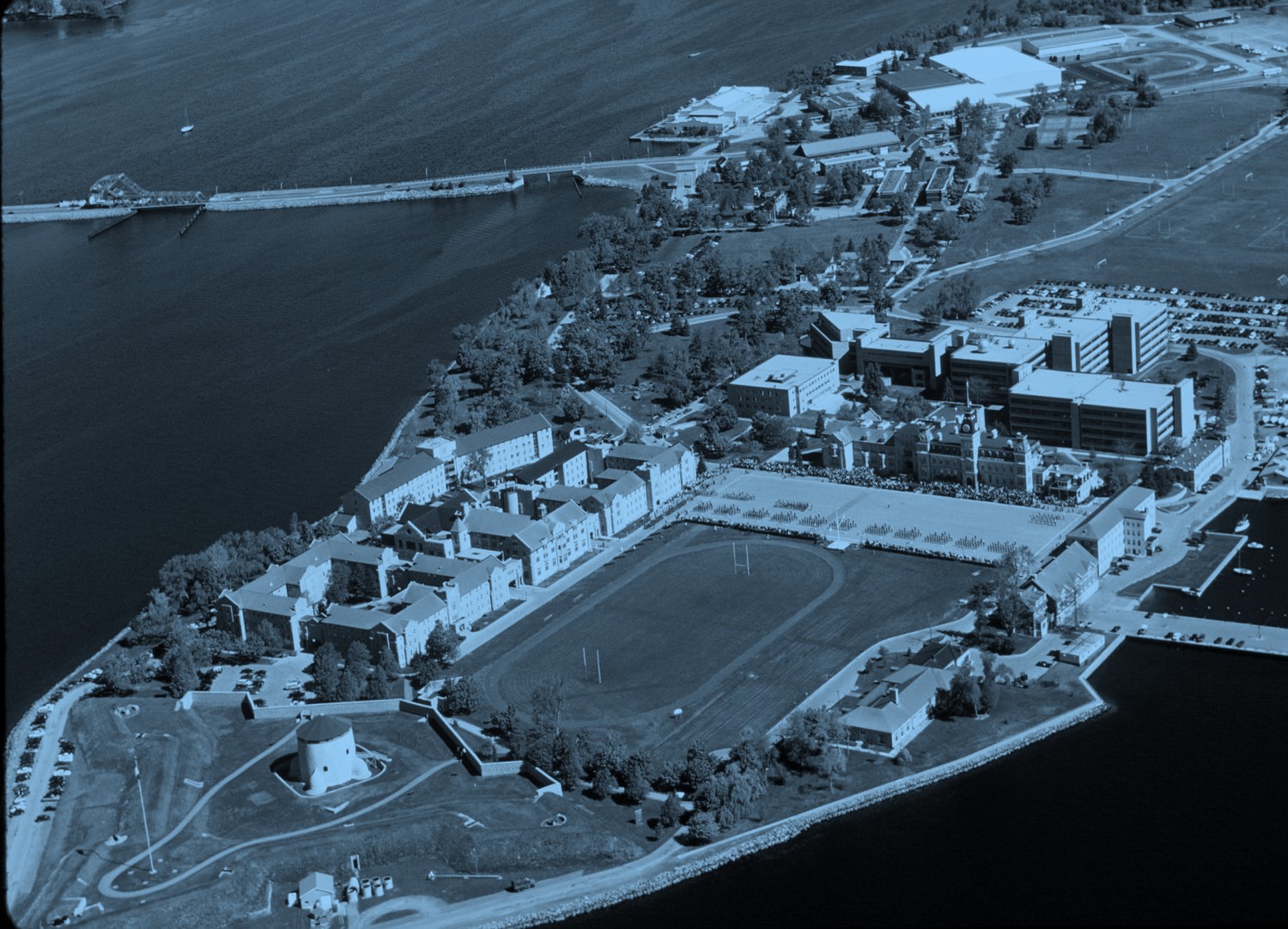
Aerial view of Royal Military College of Canada
Annex A – Defence Sites

Long description of DND RP Ops Regions
DND Property by RP Ops Regions
- North Region
- FOX-M
- Alert
- Lincoln Bay
- Wrangle Bay
- Grant
- Lake Hazen
- Ida
- Victor
- Whiskey
- Yankee
- Eureka
- Black Top Ridge
- Resolute Bay
- South Camp
- Nanisivik
- Inuvik FOL
- Whitehorse
- JTFN Yellowknife
- Rankin Inlet FOL
- Iqaluit FOL
- 5 Wg Goose Bay
- Atlantic
- CFB /ASU Gagetown
- 14 Wg Greenwood
- Det. Moncton
- CFB Shearwater
- CFB Halifax
- 9 Wg Gander
- CFS St.Johns
- Quebec
- 3 Wg Bagotville
- CFB/ASU Valcartier
- ASU Montreal
- ASU Saint-Jean
- Ontario
- 22 Wg North Bay
- Meaford LFCA TC
- CFB Borden
- ASU London
- CFB Petawawa
- ASU Toronto
- 8 Wg Trenton
- CFB Kingston
- NDHQ
- West / Ouest
- CFB/ASU Edmonton
- 4 Wg Cold Lake
- ASU Calgary
- CFB/ASU Wainwright
- CFB Suffield
- Det. Dundurn
- 15 Wg Moose Jaw
- CFB/ASU Shilo
- 17 Wg Winnipeg
- Pacific / Pacifique
- 19 Wg Comox
- CFB Esquimalt
- CFB Chilliwack
- CFS Holberg
- CFS Masset
- Central
- NDHQ
Caution: This graphic is for briefing purposes only and is not intended for navigation. The boundaries on this map must not be considered authoritative. Names on this map do not necessarily indicate official recognition of the political status of the areas concerned.
- North Region
Annex B – Overview of Implementation Approach
Defence RP Portfolio Strategy (DRPPS)
- Establishes long-term strategic direction and approach for RP portfolio management;
- Provides supporting structure and context to facilitate the integration and effective management of DND’s RP portfolio;
- Orients activities toward the achievement of results;
- Ensures alignment between high-level objectives and actions and focus on long-term affordability; and,
- Ensures good stewardship of departmental resources and compliance with GoC direction to ensure high standard of management excellence.
DRPPS Implementation Plan
- Identifies the implementation tasks/activities required to achieve the DRPPS’ strategic goals using a project management approach;
- Details implementation schedule and related approval milestones;
- Coordinates actions across multiple DND groups;
- Addresses targeted internal communication activities;
- Provides performance monitoring approach and tracking/reporting on relevant tasks/activities; and,
- Highlights post-implementation verification activities and methodology for determining level of success.
Annex C – Linkage with Departmental Documents
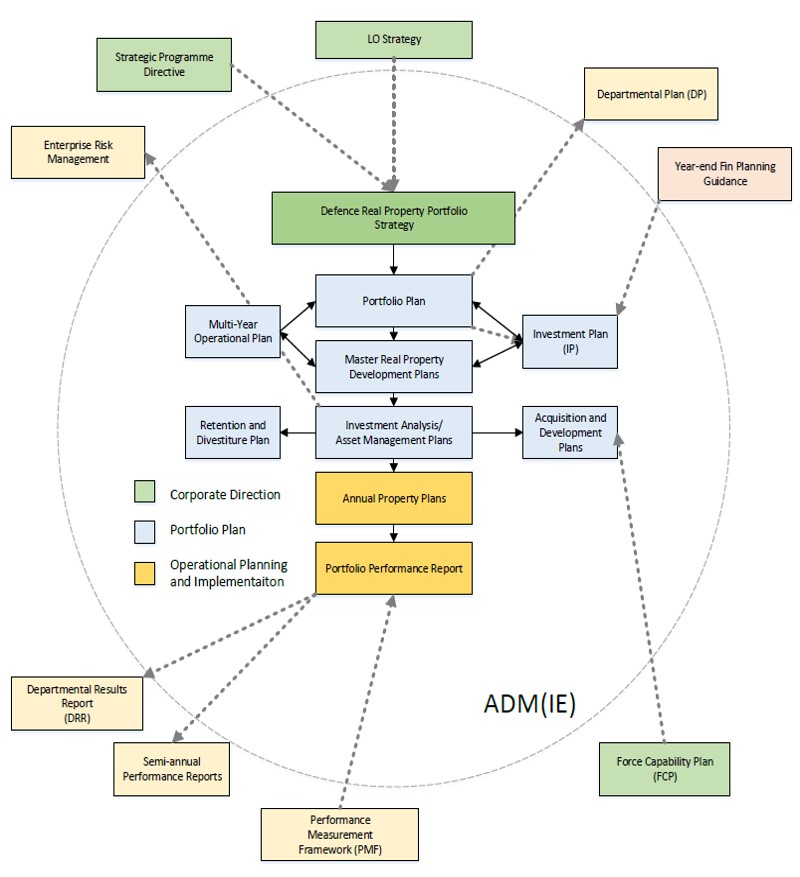
Long description of Linkage with Departmental Documents flowchart
Type of Document Documents Links to Corporate Direction L0 Strategy Defence Real Property Portfolio Strategy Corporate Direction Strategic Programme Directive Corporate Direction Defence Real Property Portfolio Strategy Portfolio Plan Portfolio Plan Portfolio Plan Investment Plan (IP) Master Real Property Development Plans Departmental Plan (DP) Portfolio Plan Master Real Property Development Plans Investment Plan (IP) Multi-Year Operational Plan Investment Analysis/Asset Management Plans Portfolio Plan Investment Plan (IP) Portfolio Plan Master Real Property Development Plans Operational Planning and Implementation Year-end Fin Planning Guidance Investment Plan (IP) Portfolio Plan Multi-Year Operational Plan Portfolio Plan Master Real Property Development Plans Portfolio Plan Investment Analysis/Asset Management Plans Retention and Divestiture Plan Acquisition and Development Plans Annual Property Plans Enterprise Risk Management Corporate Direction Force Capability Plan (FCP) Acquisition and Development Plans Operational Planning and Implementation Annual Property Plans Portfolio Performance Report Operational Planning and Implementation Portfolio Performance Report Departmental Results Report (DRR) Semi-annual Performance Reports Operational Planning and Implementation Performance Measurement Framework (PMF) Portfolio Performance Report Operational Planning and Implementation Departmental Plan (DP) N/A Portfolio Plan Retention and Divestiture Plan Operational Planning and Implementation Enterprise Risk Management Operational Planning and Implementation Departmental Results Report (DRR) Operational Planning and Implementation Semi-annual Performance Reports
Annex D – Supporting Strategic Documents
| Document | Alignment |
|---|---|
| Beyond 2020 |
|
| Canada’s Defence Policy: Strong, Secure, Engaged |
|
| Defence Energy and Environment Strategy (DEES) |
|
| Defence Investment plan [PDF, 7.4MB] |
|
| Departmental Results Framework (DRF) [PDF, 914KB] (accessible only on the National Defence network) |
|
| Directive on the Management of Real Property |
|
| Functional Planning Guidance (FPG) (accessible only on the National Defence network) |
|
| Government of Canada Fit-up Standards (GCworkplace) (you are now leaving the Government of Canada website) |
|
| Horizontal Fixed Asset Review (HFAR) |
|
| Indigenous Strategic Framework |
|
| Strategic Planning Directive (SPD) (accessible only on the National Defence network) |
|
| UN Declaration on the Rights of Indigenous Peoples (UNDRIP) (you are now leaving the Government of Canada website) |
|